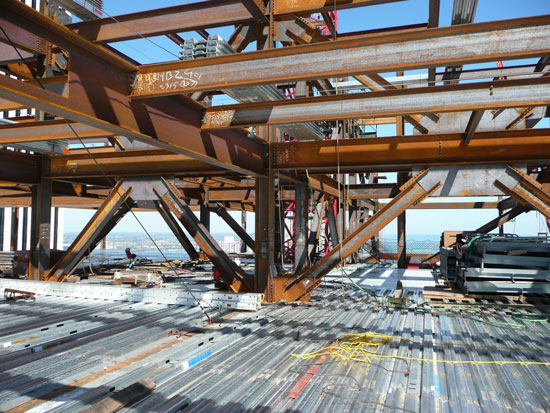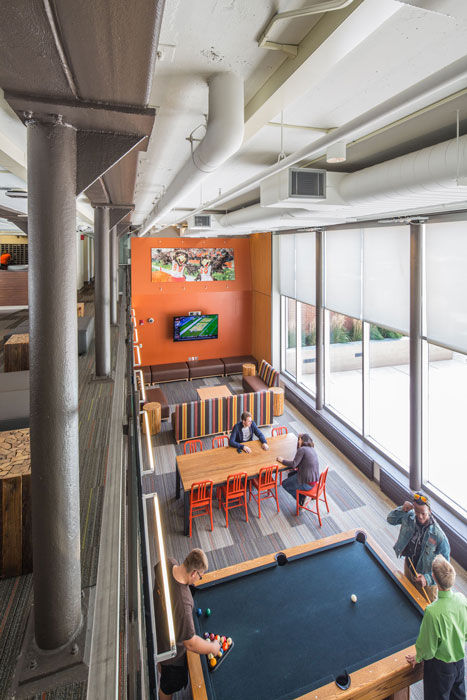Weight Watching: Adaptive Reuse with Structural Steel
Structural Expansion in Action
Looking at a number of projects that demonstrate the versatility and flexibility of structural steel, Magnusson Klemencic Associates (MKA) set out to provide the largest area of vertical expansion without over-stressing the existing foundations for Blue Cross Blue Shield in Chicago. To begin, extensive surveying was performed to confirm the tolerances and alignment of the structure. Fortunately, this alignment was such that the vertical expansion could be completed with only modest modifications to the original structure.
“Structural steel was the clear choice, given its strength-to-weight ratio and its speed of construction for the aggressive construction schedule,” relates Dave Eckman, S.E., P.E., AIA, senior principal of MKA. “The first floor of steel floor framing could be erected and decked, without the nuisance of shoring a floor slab over a roof deck that likely could not support the weight of a concrete slab.”
One unique aspect of this project involved the fact that the existing building was a steel-frame structure with two concrete cores that enclosed the vertical transportation. This meant getting workers to the job site, 500 feet above street level, was no small undertaking.
“Typically, a man-hoist is used to get people and light materials to the necessary levels under construction,” explains Eckman, “and that hoist is usually tied off to the structure every few floors to stabilize the hoist. Given that materials were loaded at street level, and the existing building was an occupied and an enclosed structure with 4,400 people working in it every day, penetrating the skin and attaching a hoist to the structure every few floors was not an option.”
Since the existing structure was steel, it was determined that the workers and materials could be lifted in one of the existing building’s service elevators to get close to the existing structure. From that point, a hoist could be built within the 30-story-tall atrium of the existing building. A hoist pit was constructed 30 stories in the air and hung over the atrium.
“The logistics and connections of an active construction hoist could not have been cost effectively achieved without steel, which was brought into the atrium in individual pieces on weekends, lifted up into the atrium, and then constructed hundreds of feet in the air, without any shoring from below the hoist pit framing,” explains Eckman.
The choice of steel leveraged a number of other advantages as well. For example, since the lateral system was comprised of steel-braced frames, as opposed to concrete core walls, the geometry could be organized to optimize efficiency. To achieve this, several bracing configurations were evaluated to determine that a 2-story X-brace would be the most efficient. This approach saved almost 300 tons of steel, compared to other bracing configurations, while still achieving similar strengths and stiffness, according to Eckman. This lightweight lateral system was less expensive than other options and allowed vertical expansion of the building by more floors without over-stressing the existing foundations.

Photo courtesy of MKA
MKA also provided the desired functionality by redesigning the original framing scheme so it accommodated the deck rotation, eliminated hundreds of reinforced beam web penetrations, reduced fabrication time and cost, and cut 0.5 pounds per square foot, resulting in 225 tons off the original design.
The lightweight steel also helped achieve the desired maximum height. In essence, the deep foundations below the two existing concrete cores did not have sufficient capacity to support 25 more floors of a concrete core, but switching materials to a structural steel cross-braced core for the vertical expansion provided sufficient strength and stiffness, without having to add additional burdening weight foundations of concrete core, he explains. If concrete cores had been required, then the vertical expansion would have been several floors shorter, resulting in much less usable space for the owner in this populated urban setting.
For this project, the use of glass also allowed core-to-glass open workspace with relatively short floor-to-floor heights. “The column-free space increased the efficiency of the floor plates, and the open floor plan allowed deeper penetration of natural light into the building. The use of steel also allowed taller ceiling heights, as the MEP systems and structural framing could occupy the same interstitial space, since the steel girders were designed with beam web penetrations to accommodate the mechanical loop as well as other MEP systems,” explains Eckman.
Although not as complex, the project requirement for SmithGroupJJR’s Bowling Green State University called for creating a more lively and engaging common area for students. However, the presence of the load-bearing masonry walls made it difficult to achieve that openness. So, steel was brought in to supplement the masonry walls. With the beams and columns, this allowed for a floor-by-floor installation carefully timed with removing the amount of supplemental, temporary shoring needed.

Photo courtesy of SmithGroupJJR/Jason Robinson Photography
For the renovation of McDonald Hall at Bowling Green State University, structural steel was used to support the existing building where interior masonry-bearing walls and a partial floor area were demolished to create a lively and open interior space. Steel columns were installed floor-by-floor to ease in phased construction and break the members into more manageable pieces.
To prevent any damage or cracks in the existing structure, the structural framing had to be stiff and strong. Furthermore, Bowling Green wanted to minimize the framing to achieve an open environment. Steel made that possible.









